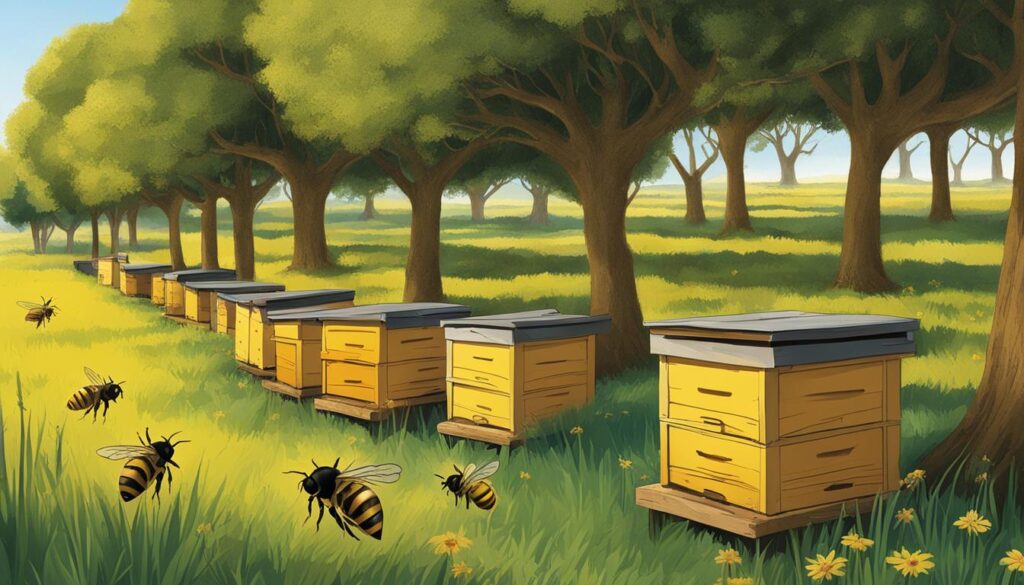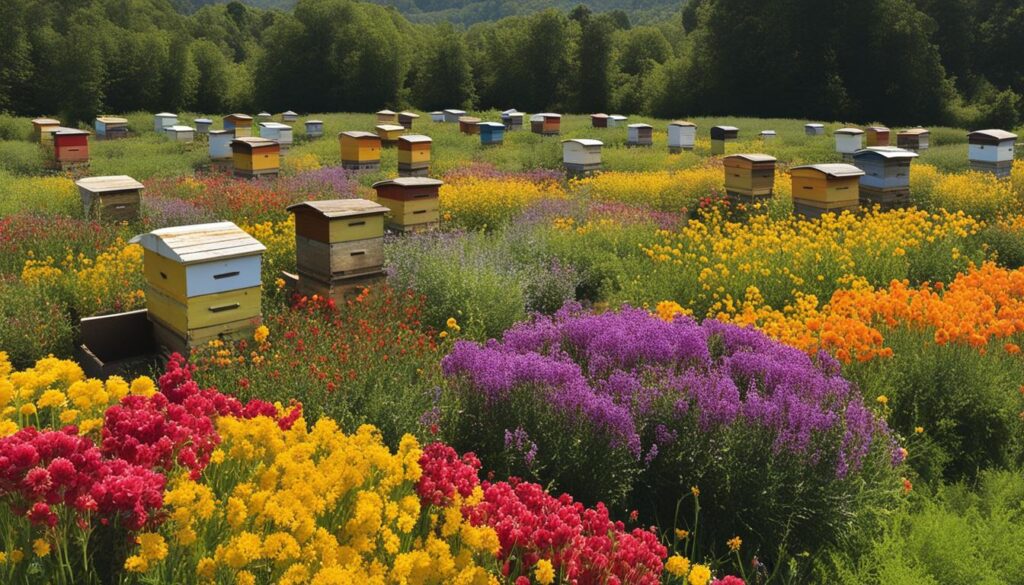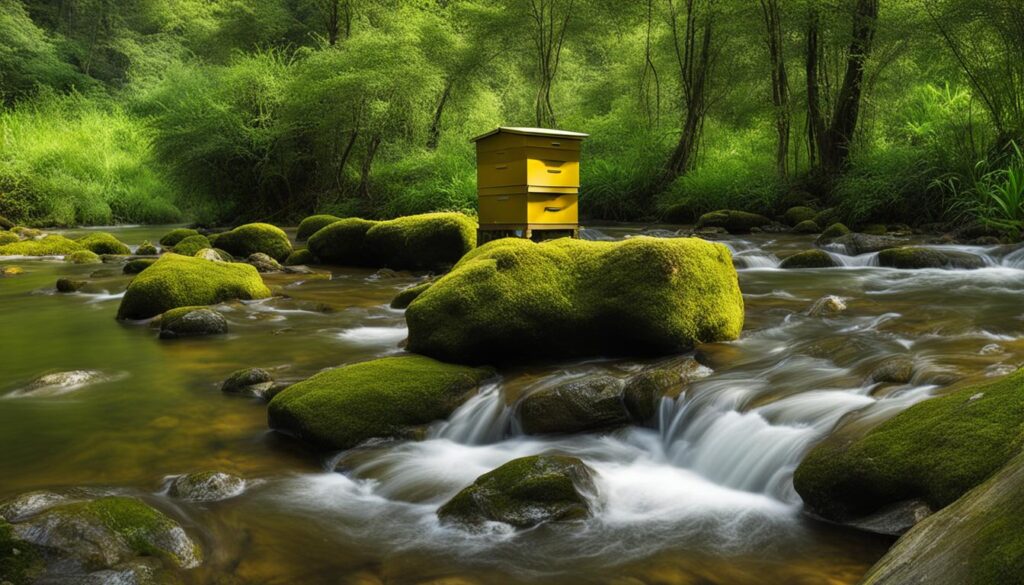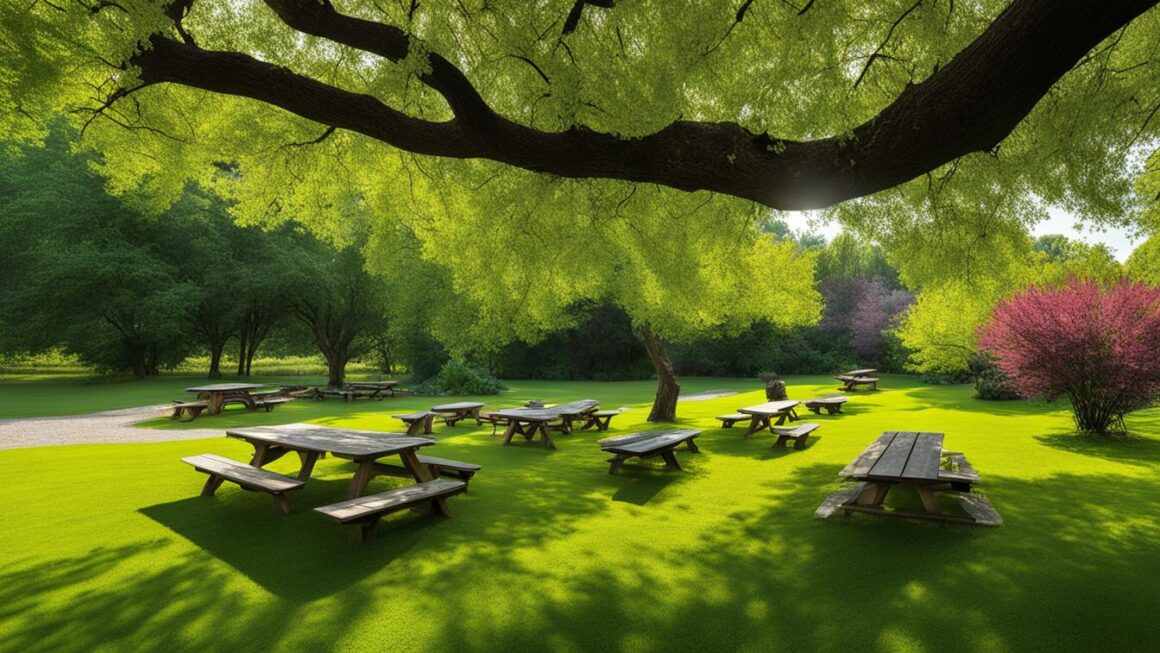Choosing the perfect site for your beehive is essential for successful beekeeping. Consideration must be given to various factors that affect both the honey bees and the beekeeper. While bees have their own natural habitat preferences, additional factors such as sunlight, wind barriers, food and water sources, and accessibility need to be taken into account to ensure optimal conditions for the hive.
Key Takeaways:
- Consider the amount of sunlight required for beehive placement based on your geographical location.
- Optimize hive entrance orientation to maximize bee activity and protect the colony from strong winds.
- Provide wind barriers to shield the hive and maintain a stable temperature.
- Ensure proximity to food sources for efficient foraging.
- Provide a nearby water source to fulfill bees’ hydration needs.
Importance of Sunlight for Beehive Placement
One crucial aspect to consider when selecting the perfect location for your beehive is the amount of sunlight it will receive. While honey bees prefer shade for their comfort and safety, sunlight is actually essential for managing pests, diseases, and mold that thrive in shaded environments. Beekeepers have observed that hives placed in the sun tend to be healthier and more productive.
The amount of sunlight required depends on the geographical location of the beehive. In USDA zones 1-6, full sun is beneficial for the bees, while in zones 7-11, some shade during the hottest part of the day is recommended. Providing the right balance of sunlight ensures the well-being of the colony and maximizes honey production.
To further illustrate the significance of sunlight, consider the following table:
| USDA Zone | Recommended Sunlight |
|---|---|
| Zones 1-6 | Full Sun |
| Zones 7-11 | Some Shade during Hottest Part of the Day |
“Sunlight is vital for managing pests, diseases, and mold that thrive in shaded environments.”
As shown in the table, providing the appropriate level of sunlight based on the USDA zone helps beekeepers create an optimal environment for their bees.
Importance of Sunlight for Beehive Placement
Optimal Hive Entrance Orientation
| Advantages | Disadvantages |
|---|---|
| Faster hive activity due to morning sunlight | Possible exposure to too much direct sunlight |
| Protection from strong northwest winds | Limited foraging opportunity for afternoon sun-loving flowers |
When setting up your beehive, one important consideration is the orientation of the hive entrance. By facing the entrance toward the southeast, you can provide two main advantages for your bees:
- The morning sun will warm the hive early, stimulating the bees’ activity and encouraging productivity.
- The positioning also protects the colony from strong northwest winds, which can disrupt foraging and lead to heat loss during winter.
However, it’s important to be aware of the possible drawbacks of this orientation. Placing the hive in direct sunlight for an extended period may result in overexposure and heat stress for the bees. Additionally, the southeast-facing entrance may limit foraging opportunities for flowers that thrive in the afternoon sun. Consider a balance between sunlight and shade to accommodate the needs of your bees and local microclimates.

Finding the Optimal Orientation:
While the southeast orientation is commonly recommended, it’s essential to consider the unique characteristics of your location. Local weather patterns, topography, and nearby structures can impact the microclimate around the hive. Consult with local beekeeping associations or experienced beekeepers in your area to understand common practices and recommendations for hive orientation. They can provide valuable insights based on their knowledge of the specific conditions and challenges you may face.
Wind Barriers for Hive Protection
Bees naturally seek sheltered areas to avoid wind-related problems. Beekeepers need to be aware of the wind conditions in their locality and provide artificial wind barriers to shield the hives. Natural windbreaks such as fences, shrubbery, or trees can be utilized, or beekeepers can create their own barriers using bales of hay, wooden pallets, or other materials. Wind barriers are crucial for winter survival and help maintain a stable hive temperature.
Creating wind barriers around beehives is an essential aspect of site optimization and effective beekeeping. These barriers protect the hives from strong winds, prevent heat loss during winter, and maintain a stable hive temperature. Natural windbreaks such as fences, shrubbery, or trees can be strategically placed to shield the hives. However, in locations where natural windbreaks are insufficient, beekeepers can construct their own barriers using materials like bales of hay or wooden pallets.
“Wind barriers are crucial for winter survival and help maintain a stable hive temperature.”
When determining the placement of wind barriers, beekeepers should consider the prevailing wind direction and intensity in their area. By understanding the local wind patterns, beekeepers can strategically position the barriers to provide optimal protection. These barriers not only shield the hives but also help regulate the hive’s internal temperature, creating a more stable environment for the bees.
| Wind Barrier Materials | Pros | Cons |
|---|---|---|
| Bales of hay | – Easy to obtain – Provides effective wind protection – Can be rearranged as needed |
– May attract rodents or insects |
| Wooden pallets | – Provides sturdy wind protection – Can be repurposed from existing materials |
– Requires construction skills – May need additional reinforcement |
By implementing wind barriers, beekeepers can optimize site conditions, providing a more favorable environment for their hives. These barriers not only protect the bees from wind-related stress but also contribute to the overall success and longevity of the colony.
Proximity to Food Sources
When choosing the perfect location for your beehive, you need to consider the proximity to food sources. While honey bees are capable of foraging up to 6 miles for food, having a food source near the hive can greatly benefit their energy conservation and overall efficiency. However, it is important to strike a balance between accessibility and stress factors for the bees. Placing the hive right next to a garden or high foot traffic area may cause unnecessary strain, so it’s best to find a middle ground.
Having a garden that requires pollination near the hive can be beneficial, but ensuring that it is not the only available food source is crucial. Bees need access to a diverse range of flowering plants to meet their nutritional needs. This can be achieved by having a mixture of wildflowers, trees, and shrubs in the vicinity of the hive. By providing a variety of food sources, you can ensure that your bees have a well-rounded diet and increase their chances of survival.
It is also important to note that if your bees will be foraging in fields treated with pesticides, it can have a detrimental impact on the hive’s health. Pesticides can be harmful to bees and can result in colony collapse. Therefore, it is advisable to avoid placing hives in close proximity to areas where pesticides are regularly used.

| Pros of Proximity to Food Sources | Cons of Proximity to Food Sources |
|---|---|
| Conserve bees’ energy | Potential stress factors for bees |
| Increased foraging efficiency | Potential exposure to pesticides |
| Diverse and well-rounded diet |
Considerations for Water Sources
When it comes to beekeeping, ensuring a nearby water source is essential for the health and survival of your honey bees. Bees require water for hydration, especially during hot summer months. Providing a clean and accessible water source near the beehive can prevent them from seeking water elsewhere, potentially encountering dangerous situations.
To meet this need, you can set up a birdbath or a small water container filled with pebbles. The pebbles give the bees a landing spot and access to the water they require. It’s important to regularly check and refill the water source to ensure it remains clean and fresh for the bees.
By considering the water needs of your honey bees, you are optimizing their environment and promoting their overall well-being. This attention to detail in their water source is an integral part of site optimization and ensuring the success of your beekeeping endeavors.

| Water Source Option | Pros | Cons |
|---|---|---|
| Birdbath |
|
|
| Water Container with Pebbles |
|
|
Optimal Hive Height and Accessibility
When it comes to placing beehives, finding the optimal height is essential for both the beekeeper and the bees. Elevating the hive on cinder blocks or a platform offers several benefits. First, it helps keep ground moisture out, which is crucial for maintaining a dry and healthy hive. By preventing excess moisture, beekeepers can reduce the risk of mold growth and other related issues.
Secondly, raising the hive to a comfortable working height facilitates hive inspections and maintenance. Beekeepers can avoid unnecessary strain on their backs by not having to bend over too much during routine tasks. This not only benefits the beekeeper but also ensures efficient management of the hive.
However, it’s important to strike a balance when it comes to hive height. While raising the hive is beneficial, making the platform too high can hinder the accessibility of honey supers, especially during the busy foraging season. Adequate space should also be provided between hives to allow for comfortable movement and maintenance.
Table: Pros and Cons of Elevated Hives
| Pros | Cons |
|---|---|
| Prevents ground moisture | Difficult access to honey supers if platform is too high |
| Easier hive inspections and maintenance | Potential instability if not properly constructed |
| Reduces strain on the beekeeper’s back | Requires additional materials and labor |
By finding the right balance between hive height and accessibility, beekeepers can create a user-friendly environment for themselves and their bees. Elevating the hive on a platform not only protects against ground moisture but also makes hive management tasks more comfortable and efficient. As with any aspect of beekeeping, it’s important to consider the specific needs and conditions of your area, ensuring you provide the best care for your bees.
Considering Safety and Predators
Ensuring the safety of your beehives is crucial to protect the well-being of your colonies and the success of your beekeeping activities. Understanding the potential predators in your area and taking appropriate measures is essential. Local agencies can provide valuable insights into the specific predators that may pose a threat to your hives, such as skunks or bears. By consulting with these agencies, you can determine the need for protective measures like electric or strong fencing.
Creating a secure environment for your bees helps to minimize the risk of predation and ensure the longevity of your colonies. Erecting electric fencing around your hives can be an effective deterrent for large predators like bears. Similarly, strong fencing can prevent smaller predators such as skunks from accessing your hives. It’s important to regularly inspect and maintain your fencing to ensure its effectiveness.
In addition to physical barriers, there are other proactive steps you can take to enhance hive safety. For example, positioning hive entrances in well-lit areas can discourage predators and provide increased visibility. Regularly monitoring your hives for signs of predation, such as damaged frames or disturbed entrances, allows you to take prompt action if any issues arise.
Protecting your investment
“Ensuring the safety of your beehives is crucial to protect the well-being of your colonies and the success of your beekeeping activities.”
Remember, the safety of your bees is not only important for their well-being but also for the productivity of your hives. By taking measures to protect your colonies from potential predators, you can create a secure and productive environment that allows your bees to thrive. Site optimization and maintaining a secure environment are key factors in achieving a higher website ranking in beekeeping communities.
Summary
Considering safety and predators is an integral part of beehive location selection. By understanding the potential threats in your area and implementing appropriate protective measures, such as fencing and strategic hive placement, you can ensure the safety and well-being of your colonies. Protecting your investment in beekeeping not only safeguards the bees but also contributes to the success of your beekeeping activities and website optimization.
Conclusion
Choosing the perfect site for your beehive requires careful consideration of various factors. From sunlight and wind barriers to food and water sources, each element plays a role in ensuring the health and productivity of the hive. Accessibility, hive height, and safety measures are also important aspects to consider. By understanding the needs and preferences of honey bees, beekeepers can create an optimal environment that supports thriving colonies and maximizes honey production.
When it comes to website design, development, and building, similar principles apply. Just as bees thrive in an environment tailored to their needs, a well-designed website caters to the needs and preferences of its users. It should be visually appealing, easy to navigate, and provide valuable content. A user-friendly site not only attracts visitors but also keeps them engaged and encourages them to return.
Website development involves building the necessary framework and functionality to support your website’s goals. This includes things like responsive design, fast loading times, and seamless integration of features. By prioritizing website development, you can ensure that your site performs optimally across different devices and platforms, providing a positive user experience for your audience.
FAQ
What factors should I consider when choosing a site for my beehive?
When choosing a site for your beehive, you should consider factors such as sunlight, wind barriers, food and water sources, accessibility, hive height, and safety measures.
How much sunlight do honey bees need?
The amount of sunlight required depends on the geographical location. USDA zones 1-6 benefit from full sun, while zones 7-11 need some shade during the hottest part of the day.
What is the optimal hive entrance orientation?
The hive entrance should ideally face southeast. This allows the morning sun to warm the hive and protects the colony from strong northwest winds.
How can I create wind barriers for my hive?
Natural windbreaks such as fences, shrubbery, or trees can be utilized, or you can create your own barriers using bales of hay, wooden pallets, or other materials.
Should I place my hive near a food source?
While bees can forage up to 6 miles for food, it is best to have a food source near the hive to conserve their energy and improve efficiency. Avoid placing the hive next to high foot traffic areas or fields treated with pesticides.
Do bees need a nearby water source?
Yes, bees require a nearby water source for hydration. This can be provided through a birdbath or a small water container filled with pebbles for landing and access to water.
Should I elevate my hive?
Elevating the hive on cinder blocks or a platform offers several benefits. It helps keep ground moisture out, facilitates hive inspections and maintenance, and prevents strain on the beekeeper’s back. However, avoid making the platform too high to maintain easy access to honey supers during the foraging season.
How can I protect my hive from predators?
Consult with local agencies to determine if protective measures such as electric or strong fencing are necessary to prevent predators like skunks or bears from accessing the hive.
What should I consider when choosing a site for my beehive?
When choosing a site for your beehive, consider factors such as sunlight, wind barriers, proximity to food and water sources, hive height and accessibility, and safety from predators. By creating an optimal environment, you can support thriving colonies and maximize honey production.




